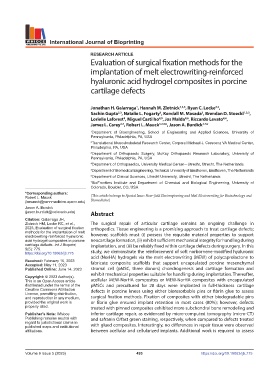Page 501 - IJB-9-5
P. 501
International Journal of Bioprinting
RESEARCH ARTICLE
Evaluation of surgical fixation methods for the
implantation of melt electrowriting-reinforced
hyaluronic acid hydrogel composites in porcine
cartilage defects
Jonathan H. Galarraga , Hannah M. Zlotnick 1,2,3 , Ryan C. Locke ,
1
2,3
Sachin Gupta , Natalie L. Fogarty , Kendall M. Masada , Brendan D. Stoeckl 1,2,3 ,
3
2,3
3
Lorielle Laforest , Miguel Castilho , Jos Malda , Riccardo Levato ,
4,6
4,6
4,5
3
James L. Carey , Robert L. Mauck 1,2,3 *, Jason A. Burdick *
2,3
1,7
1 Department of Bioengineering, School of Engineering and Applied Sciences, University of
Pennsylvania, Philadelphia, PA, USA
2 Translational Musculoskeletal Research Center, Corporal Michael J. Crescenz VA Medical Center,
Philadelphia, PA, USA
3
Department of Orthopaedic Surgery, McKay Orthopaedic Research Laboratory, University of
Pennsylvania, Philadelphia, PA, USA
4 Department of Orthopaedics, University Medical Center—Utrecht, Utrecht, The Netherlands
5 Department of Biomedical Engineering, Technical University of Eindhoven, Eindhoven, The Netherlands
6 Department of Clinical Sciences, Utrecht University, Utrecht, The Netherlands
7
BioFrontiers Institute and Department of Chemical and Biological Engineering, University of
Colorado, Boulder, CO, USA
*Corresponding authors:
Robert L. Mauck (This article belongs to Special Issue: Near-field Electrospinning and Melt Electrowriting for Biotechnology and
(lemauck@pennmedicine.upenn.edu) Biomedicine)
Jason A. Burdick
(jason.burdick@colorado.edu) Abstract
Citation: Galarraga JH,
Zlotnick HM, Locke RC, et al., The surgical repair of articular cartilage remains an ongoing challenge in
2023, Evaluation of surgical fixation orthopedics. Tissue engineering is a promising approach to treat cartilage defects;
methods for the implantation of melt
electrowriting-reinforced hyaluronic however, scaffolds must (i) possess the requisite material properties to support
acid hydrogel composites in porcine neocartilage formation, (ii) exhibit sufficient mechanical integrity for handling during
cartilage defects. Int J Bioprint, implantation, and (iii) be reliably fixed within cartilage defects during surgery. In this
9(5): 775.
https://doi.org/10.18063/ijb.775 study, we demonstrate the reinforcement of soft norbornene-modified hyaluronic
acid (NorHA) hydrogels via the melt electrowriting (MEW) of polycaprolactone to
Received: February 15, 2023 fabricate composite scaffolds that support encapsulated porcine mesenchymal
Accepted: May 11, 2023
Published Online: June 14, 2023 stromal cell (pMSC, three donors) chondrogenesis and cartilage formation and
exhibit mechanical properties suitable for handling during implantation. Thereafter,
Copyright: © 2023 Author(s).
This is an Open Access article acellular MEW-NorHA composites or MEW-NorHA composites with encapsulated
distributed under the terms of the pMSCs and precultured for 28 days were implanted in full-thickness cartilage
Creative Commons Attribution defects in porcine knees using either bioresorbable pins or fibrin glue to assess
License, permitting distribution,
and reproduction in any medium, surgical fixation methods. Fixation of composites with either biodegradable pins
provided the original work is or fibrin glue ensured implant retention in most cases (80%); however, defects
properly cited. treated with pinned composites exhibited more subchondral bone remodeling and
Publisher’s Note: Whioce inferior cartilage repair, as evidenced by micro-computed tomography (micro-CT)
Publishing remains neutral with and safranin O/fast green staining, respectively, when compared to defects treated
regard to jurisdictional claims in
published maps and institutional with glued composites. Interestingly, no differences in repair tissue were observed
affiliations. between acellular and cellularized implants. Additional work is required to assess
Volume 9 Issue 5 (2023) 493 https://doi.org/10.18063/ijb.775

